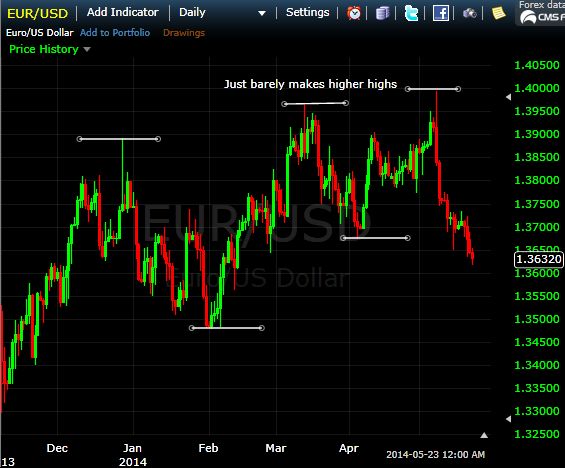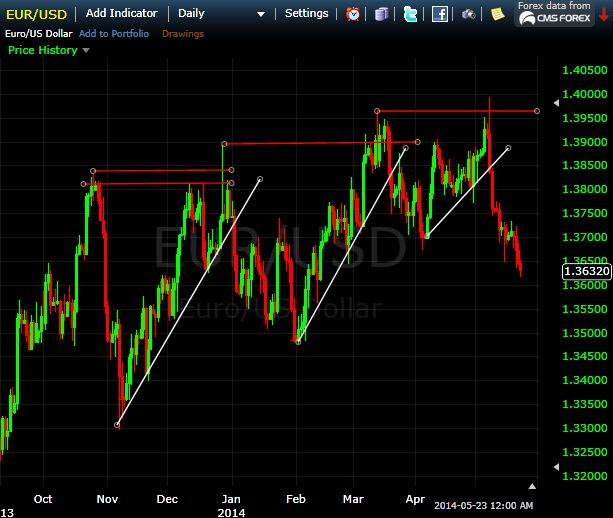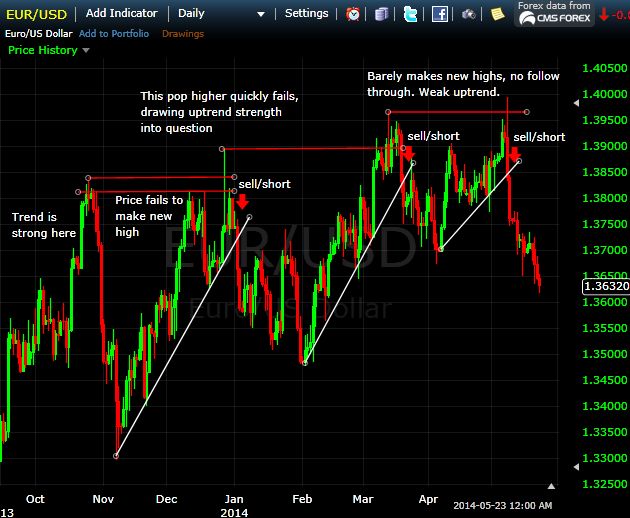Trading False Breakout in Weak Trends
Many traders try to trade breakouts, but many of those breakouts fail resulting in a losing trade. A failed breakout is when the price moves beyond a former high or former low, making it appear like the price is going to continue to run in that direction. Instead, the price quickly reverses, trapping a bunch of traders in a losing position. Instead of getting frustrated by false breakouts, learn to trade them and profit from them. Here’s one way to do it.
Watch for Weak Trends
First we need to isolate forex pairs, or other assets, where a false breakout is likely to occur. False breakouts often occur in weak trends.
A downtrend is weak when the price is making lower swing lows, but just barely. The price will make a new low, then reverse course. The price is “drifting” lower, as opposed to getting “hammered” lower. Since we are going to be buying when the trend is down, we need the trend to be weak. We don’t want to buy in a downtrend when that trend is strong and the price is creating significantly lower lows on each price wave.
An uptrend is weak when the price is making higher swing highs, but just barely. Figure 1 shows an example of this. The EUR/USD is just barely making higher highs. This shows some potential underlying weakness, as the bulls are just barely stronger than the bears. Therefore, if we know how to trade it, we can take short position within this pair and make money even though the trend is slightly up.
Figure 1. EURUSD Daily Chart with Weak Uptrend

Introduce the Trendline
Now that we have isolated a weak trend, in this case a weak uptrend in the EUR/USD, we mark former high points with horizontal (red) lines. This way, when the price makes a new high it is visible.
We then put trendlines on the waves higher which created the new high. Figure 2 shows these two steps applied to a few trusts higher in the EUR/USD.
Figure 2. EURUSD Daily Chart with Highs and Waves Higher Marked

The horizontal lines (red) mark former highs, so assuming we have a weak trend when the price crosses above the red line we want to watch for a false breakout. If the price moves above the former high (red lines) but then quickly reverses course (in this cause, down) we have a potential false breakout.
Our trendlines help us confirm the false breakout. If the price just barely creates a new high and then drops below our trendline, enter a short position as the price crosses below the trendline. Typically the price will fall fast as lots of traders are forced to liquidate because the price failed to rally as expected.
Figure 3. EURUSD False Breakout Trades

In each of these cases we had evidence to suggest that the uptrend wasn’t very strong. Even so, we give the weak uptrend some credit and give it a chance to move higher. This is why we wait to go short until the price crosses below the trendline.
Other Considerations
This is a generic strategy, in that it will need your own personal touch to make it usable. If you’ve isolated a weak trend and spot the false breakouts, the price will typically move in your favor, at least for a short while. If trading traditional markets (such as forex) risk control can be an issue, since false breakout bars can be quite large, and if you place a stop above it your stop could be quite large as well.
Therefore, you’ll have to balance the risk with reward. Fibonacci Retracement levels provide viable exits, with the 50% level being a frequent target price. Based on the entry, stop and target, your reward should be greater than your risk; if it isn’t skip the trade.
For binary option traders you’ll need to establish your expiry. Look at the history of prior false breakout trade set-ups to find an average expiry time which provides the greatest potential of the option expiring in the money.
While daily charts were used in this example, the strategy is usable on all time frames.
The same strategy applies to weak downtrends.
Final Word
We don’t want to short into a strong uptrend (or buy into a strong downtrend), only when the price trend is weak should we apply this strategy. This is only a partial strategy, as it just gives the entry point. While the price will typically run in our favor for a time, it is up to you to complete the strategy by finding a viable exit on the timeframe you trade on.